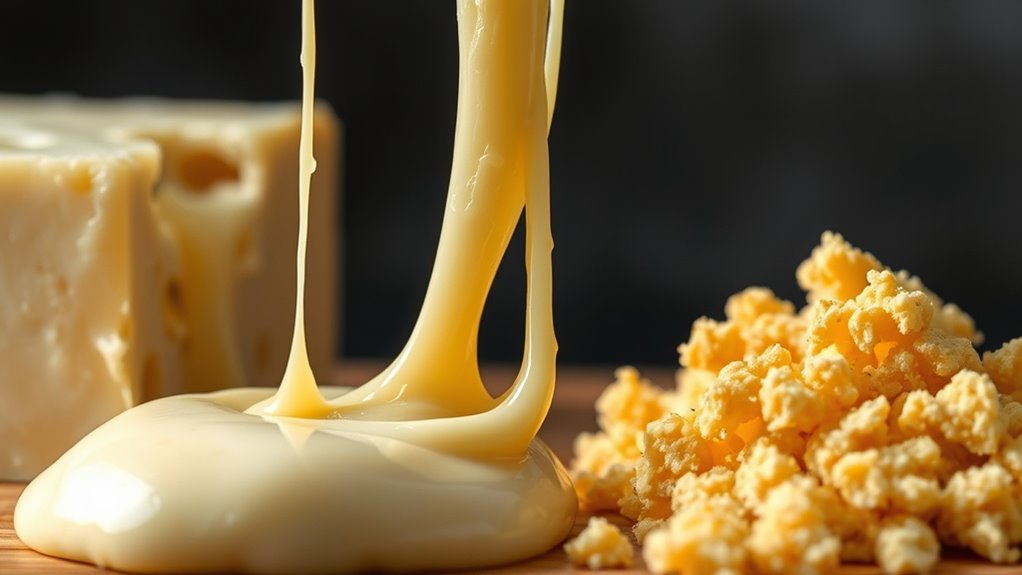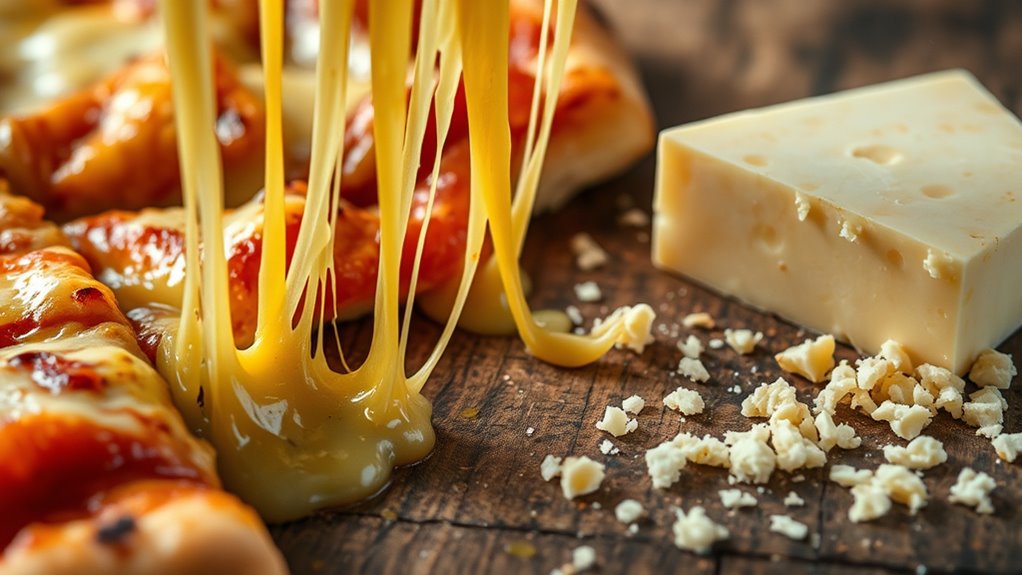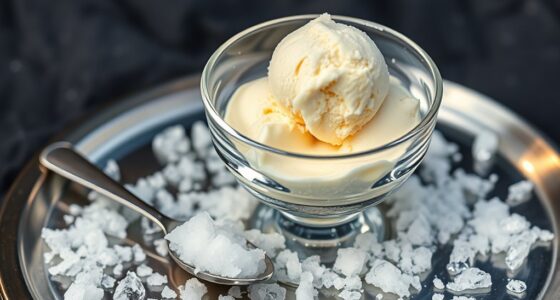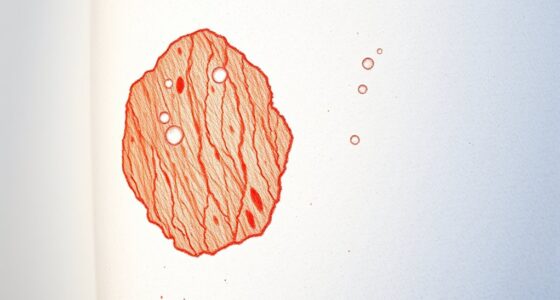Cheeses that stretch, like mozzarella and provolone, have high moisture, fat, and a flexible protein network that allows them to melt smoothly and stretch when heated. In contrast, cheeses like feta or Parmesan are drier, with tightly packed proteins, making them crumble rather than melt. Understanding these differences helps you choose the right cheese for your dish. Keep exploring to learn more about what makes each cheese behave the way it does.
Key Takeaways
- Cheeses that stretch have high moisture, fat content, and a flexible protein network, allowing them to soften and elongate when heated.
- Crumbling cheeses have low moisture and dense protein structures, causing them to break apart rather than melt smoothly.
- Melting cheeses like mozzarella contain a protein matrix that becomes soft and elastic upon heating, while crumbly cheeses lack this flexibility.
- The moisture level in cheese influences its ability to melt; higher moisture promotes stretchiness, while lower moisture leads to crumbling.
- The specific protein structure and fat content determine whether cheese will soften and stretch or break into pieces when heated.

When choosing cheese for your favorite dishes, understanding whether it stretches or crumbles can make a big difference in the final result. The key lies in the cheese’s melting properties, which are influenced by its moisture content, fat levels, and protein structure. Cheeses that melt well tend to have higher moisture and fat content, which allows the cheese to become gooey and stretch when heated. Conversely, cheeses that crumble usually have lower moisture and a firmer protein matrix, causing them to break apart rather than stretch. Recognizing these differences helps you select the right cheese for your culinary uses of cheese, whether you’re making a melty pizza or a crisp cheese topping.
Cheese melting properties are primarily determined by the type of proteins and moisture in the cheese. For instance, cheeses like mozzarella and provolone are known for their excellent melting qualities. They contain a high amount of moisture and a specific protein network that allows the cheese to soften and stretch without losing its structure. This makes them ideal for dishes where a gooey, elastic texture is desired, such as pizza, lasagna, or grilled sandwiches.
On the other hand, cheeses like feta or Parmesan have a denser, drier structure. Their proteins are tightly packed, and they lack the moisture necessary to melt smoothly, which causes them to crumble rather than stretch.
The culinary uses of cheese are directly impacted by these properties. If you’re aiming for a stretchable cheese topping or filling, you’ll want to choose cheeses with good melting properties. Mozzarella, for example, is a classic choice for pizza because it melts evenly and stretches beautifully. Cheeses with excellent melting qualities can also be used in sauces, where their ability to melt smoothly creates a rich, cohesive texture.
In contrast, if you’re adding cheese as a topping that should retain its shape or be crumbled over a salad, cheeses that crumble are more appropriate. Feta, blue cheese, and cotija are perfect for these purposes, adding flavor and texture without melting into a gooey mess.
Understanding the difference between cheeses that stretch and those that crumble helps you elevate your culinary creations. You can pick the right cheese based on the desired outcome—whether you want a stretchy, melty experience or a crumbly, flavorful bite. Recognizing the cheese melting properties and their culinary uses ensures your dishes turn out just as you envision, making your cooking more intentional and satisfying.
Frequently Asked Questions
Can Cheese Texture Change Over Time?
Yes, cheese texture can change over time. As cheese ages, its flavor develops, and its melting properties may alter, affecting how it behaves when heated.
You might notice that a young cheese melts smoothly, while an older one crumbles more easily. These changes depend on factors like moisture content and aging process.
Does Moisture Content Affect Cheese Stretching?
Did you know that cheese with higher moisture levels, like mozzarella, can stretch up to 60% more than drier varieties?
Moisture content directly impacts cheese elasticity, making it more pliable and stretchable. When moisture levels are high, the cheese’s protein networks remain flexible, allowing it to stretch without breaking.
Are There Health Benefits to Cheese Types?
You might wonder if different cheese types offer health benefits. Some cheeses, rich in calcium, support strong bones and improve calcium absorption, aiding your dairy digestion.
Hard cheeses like Parmesan provide high calcium levels, while softer ones like ricotta are easier to digest. Choosing a variety helps you get essential nutrients and promotes better dairy digestion, making cheese a tasty way to boost your overall health.
How Does Aging Influence Cheese Crumble?
Imagine a cheese like a vintage vinyl—its aging effects truly matter. As cheese ages, it undergoes flavor development and moisture loss, which influences whether it crumbles or stays elastic.
Younger cheeses tend to be more supple, while aged ones develop a firmer, crumbly texture. The aging process enhances taste but also causes proteins to break down, making the cheese more prone to crumbling, especially in varieties like Parmesan or aged cheddar.
Can Cooking Alter a Cheese’S Stretchiness?
Cooking definitely alters a cheese’s stretchiness by affecting its melting properties and cheese elasticity. When you heat cheese, its proteins and fats break down, making it melt more smoothly, which enhances its ability to stretch.
Different cheeses have varying levels of cheese elasticity, so some melt and stretch beautifully, while others crumble instead.
Conclusion
Understanding why some cheeses stretch while others crumble helps you appreciate their unique personalities. Think of cheese like a dance partner—some glide smoothly across the floor, stretching gracefully, while others tap out sharp, quick steps. By recognizing these differences, you can choose the perfect cheese for your dish or snack, turning your culinary experience into a beautifully choreographed performance. So next time, pick wisely and let your cheese’s personality shine through!









